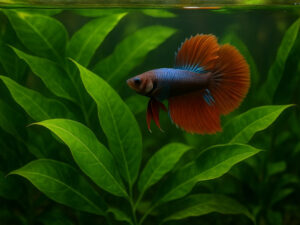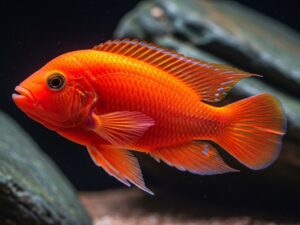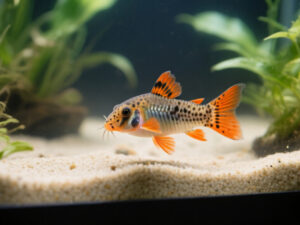If you're looking for a colorful freshwater fish that combines stunning appearance with manageable care requirements, the peacock gudgeon deserves your attention. This jewel-like species, scientifically known as Tateurndina ocellicauda, brings a splash of iridescent blue and yellow to any aquarium while maintaining a peaceful temperament that makes it perfect for community tanks.
Native to the shallow streams and ponds of Papua New Guinea, peacock gudgeons have captured the hearts of aquarists worldwide with their distinctive appearance and fascinating behavior. Despite their exotic looks, these small fish adapt well to aquarium life when provided with the right conditions. In this comprehensive guide, I'll walk you through everything you need to know about caring for these beautiful fish, from setting up their tank to breeding success.
Species Overview and Natural Habitat
The peacock gudgeon belongs to the Eleotridae family, commonly known as sleeper gobies. Unlike true gobies, peacock gudgeons lack the fused pelvic fins that form a suction cup. This taxonomic distinction gives them unique swimming patterns and behavioral traits that set them apart from their goby cousins.
In their natural habitat, peacock gudgeons inhabit slow-moving or still waters in eastern Papua New Guinea. These waters typically feature dense vegetation, fallen branches, and leaf litter that create numerous hiding spots and breeding sites. The streams they call home have soft, slightly acidic to neutral water with temperatures ranging from 72-79°F (22-26°C). Understanding these natural conditions helps us recreate an optimal environment in our aquariums.
Adult peacock gudgeons reach a modest size of 2.5 to 3 inches (6-7.5 cm), making them suitable for smaller aquarium setups. Their body displays an electric blue base color with bright red-orange vertical stripes along the flanks. The fins showcase yellow edges with distinctive black spots, particularly prominent on the dorsal and anal fins. Males develop a pronounced nuchal hump (forehead bump) during maturity, while females maintain a more streamlined profile with a rounder belly.
With proper care, peacock gudgeons typically live 4-5 years in captivity, though some aquarists report specimens reaching 6-7 years. It's worth noting that the IUCN Red List classified this species as Vulnerable in 2019 due to habitat loss in their native range, making responsible captive breeding increasingly important for conservation efforts.
Tank Setup and Requirements
Creating the ideal environment for peacock gudgeons starts with choosing the right tank size. While these fish are relatively small, I recommend a minimum of 15 gallons for a pair, with 20-30 gallons being ideal for a small group of 4-6 individuals. The extra space not only provides swimming room but also helps establish territories and reduces potential conflicts during breeding.
Substrate selection plays an important role in peacock gudgeon comfort. Fine sand or smooth gravel works best, as these fish occasionally sift through the substrate searching for food. Dark-colored substrates help enhance their bright colors and make them feel more secure. Avoid sharp or coarse materials that could damage their delicate fins or barbels.
Essential Tank Features
Caves and hiding spots are absolutely essential for peacock gudgeons. In my experience, providing at least one cave per fish prevents territorial disputes and encourages natural behavior. You can use commercially available ceramic caves, PVC pipe sections cut in half, coconut shells, or carefully arranged rocks. Position caves at various heights and orientations to give fish options for establishing territories.
Plant selection should focus on species that thrive in similar water conditions. Java fern, Anubias, and Cryptocoryne species work exceptionally well, providing cover without demanding high light levels. Floating plants like water sprite or Amazon frogbit help diffuse lighting and create shadowy areas that peacock gudgeons appreciate. Dense plantings along the tank's back and sides leave open swimming space in the center while maintaining the security these fish need.
Filtration should provide gentle to moderate flow, as peacock gudgeons come from relatively calm waters. A quality sponge filter or a hang-on-back filter with adjustable flow works perfectly. Strong currents stress these fish and make feeding difficult, so aim for water movement that's just enough to maintain good oxygenation without creating powerful currents.
Water Parameters and Maintenance
Maintaining stable water parameters is essential for peacock gudgeon health and longevity. These fish show remarkable adaptability to various conditions, but consistency matters more than hitting exact numbers. Temperature should stay between 72-79°F (22-26°C), with 75-77°F (24-25°C) being optimal for general maintenance.
The pH range for peacock gudgeons extends from 6.0 to 7.5, though they seem happiest in slightly acidic to neutral water around 6.5-7.0. Water hardness can vary from 5-12 dGH, making them suitable for most tap water conditions after proper conditioning. Always use a quality water conditioner to remove chlorine and chloramines before adding new water to the tank.
Regular water changes form the foundation of good aquarium maintenance. I perform 25-30% water changes weekly, which helps maintain water quality without causing drastic parameter shifts. During water changes, vacuum the substrate gently to remove debris while avoiding disruption of cave arrangements or plant roots. Test water parameters weekly using a reliable test kit, paying special attention to ammonia, nitrite, and nitrate levels.
Diet and Feeding Requirements
In their natural habitat, peacock gudgeons are micro-predators, feeding on small invertebrates, insect larvae, and zooplankton. This carnivorous tendency means they require a protein-rich diet in captivity. While they can learn to accept high-quality flakes and pellets, live and frozen foods should form the bulk of their diet for optimal health and coloration.
Live foods drive peacock gudgeons wild with excitement. Brine shrimp, daphnia, and blackworms are excellent choices that trigger natural hunting behaviors. If you're interested in culturing your own live foods, brine shrimp are particularly easy to hatch at home. Microworms and vinegar eels work well for juveniles or as supplementary foods for adults.
Feeding Schedule and Techniques
Frozen foods offer convenience while still providing excellent nutrition. Bloodworms, mysis shrimp, and cyclops are readily accepted once thawed. I've found that peacock gudgeons respond best to frozen foods when they're thawed in tank water and delivered via a turkey baster near their hiding spots. This targeted feeding ensures shy individuals get their share.
Feed adult peacock gudgeons twice daily, offering only what they can consume in 2-3 minutes. These fish have small stomachs, so multiple small meals are better than one large feeding. Young fish and breeding pairs benefit from three smaller feedings daily to support growth and egg production.
Some peacock gudgeons can be notoriously picky eaters, especially when first introduced to a new tank. If you encounter feeding difficulties, try offering live baby brine shrimp to stimulate their appetite. Once they're eating reliably, gradually introduce frozen foods by mixing them with live offerings. Most individuals eventually accept high-quality micro-pellets, though this transition can take several weeks of patience.
Behavior and Social Dynamics
Peacock gudgeons exhibit fascinating social behaviors that make them engaging aquarium residents. Generally peaceful, they reserve aggression for territorial disputes among males or during breeding. Males establish and defend small territories centered around caves, displaying to females and rival males with spread fins and intensified colors.
Group dynamics work best with a ratio of one male to two or three females, which distributes male attention and reduces female stress during breeding attempts. In larger tanks, multiple males can coexist if sufficient caves and visual barriers prevent constant confrontation. I've successfully kept groups of 6-8 peacock gudgeons in a 40-gallon tank with minimal aggression by providing abundant hiding spots.
These fish display distinct personality traits, with some individuals being bold explorers while others remain shy and reclusive. Activity peaks during dawn and dusk hours, mimicking their natural crepuscular patterns. During the day, they often rest near caves or among plants, becoming more active as lighting dims. This behavior makes them excellent candidates for aquariums with programmable LED lights that simulate natural dawn and dusk transitions.
Compatible Tank Mates
Selecting appropriate tank mates for peacock gudgeons requires consideration of their peaceful nature and relatively small size. The best companions are other peaceful fish that won't compete aggressively for food or territory. Small tetras like neons, cardinals, and ember tetras make excellent choices, as do peaceful livebearers like guppies and endlers.
Rasboras, particularly harlequin and lambchop varieties, share similar water requirements and temperaments. Small catfish species such as Corydoras and Otocinclus help with tank maintenance while staying out of peacock gudgeon territories. Dwarf cichlids like Apistogramma can work in larger tanks where territories don't overlap.
Avoid housing peacock gudgeons with large, aggressive, or overly active fish. Cichlids larger than rams, tiger barbs, and other fin-nippers will stress or injure these gentle fish. Fast-swimming species like danios might outcompete them for food. Similarly, avoid bottom-dwelling fish that compete for caves, such as other gudgeon species or territorial loaches.
Invertebrates generally coexist well with peacock gudgeons. Cherry shrimp, Amano shrimp, and adult dwarf shrimp thrive alongside them, though tiny shrimplets might become snacks. Nerite snails and mystery snails help with algae control without bothering the fish.
Breeding Peacock Gudgeons
Breeding peacock gudgeons rewards patient aquarists with fascinating parental behavior and adorable fry. Sexual dimorphism becomes apparent as fish mature around 6-8 months old. Males develop the characteristic nuchal hump, display brighter colors, and grow slightly larger. Females remain smaller with rounder bellies and less intense coloration, though they're still quite attractive fish.
Breeding Setup and Conditioning
Successful breeding starts with proper conditioning. Feed potential breeding pairs high-quality live and frozen foods for 2-3 weeks before attempting to spawn. Maintain pristine water conditions and slightly increase the temperature to 77-79°F (25-26°C). Some breeders report success triggering spawning by performing larger water changes with slightly cooler water, mimicking seasonal rains.
The breeding setup doesn't require a separate tank, though some aquarists prefer the control a dedicated breeding tank provides. Whether breeding in their main tank or a separate setup, ensure each male has access to at least one suitable cave. PVC pipes with a 1-inch diameter work perfectly, as do commercial breeding caves designed for dwarf cichlids.
Males intensify their colors and begin displaying near chosen caves, performing elaborate dances to attract females. Ready females develop noticeably swollen bellies and might display a pink or reddish hue near their vent. Once a female shows interest, she'll enter the male's cave to inspect it. If satisfied, she'll deposit 50-100 small adhesive eggs on the cave ceiling.
Parental Care and Fry Rearing
After spawning, the male takes full responsibility for the eggs, fanning them constantly and defending the cave against intruders. This devoted parental care continues for 7-10 days until the eggs hatch. The male might not eat during this period, so don't worry if he ignores food offerings.
Once hatched, the tiny fry remain in the cave for another 2-3 days absorbing their yolk sacs. When they become free-swimming, they'll venture out in search of food. At this stage, they require microscopic foods like infusoria, green water, or commercially available liquid fry food. After a week, they can handle newly hatched brine shrimp and microworms.
Fry growth depends heavily on feeding frequency and water quality. Feed them 3-4 times daily and perform small daily water changes to maintain optimal conditions. Young peacock gudgeons reach about 1 inch within 3 months and show adult coloration around 4-5 months. Separate males if aggression becomes problematic as they mature.
Breeding success often improves with experience. First-time parents might eat eggs or abandon them prematurely. Don't be discouraged if initial attempts fail - peacock gudgeons typically become better parents with practice. Keep detailed notes about water parameters, feeding schedules, and behaviors that preceded successful spawns. This information helps replicate conditions for future breeding attempts.
For serious breeding projects, consider setting up multiple breeding tanks to separate pairs and maximize fry production. A simple 10-gallon tank with a sponge filter, heater, and several caves works perfectly as a dedicated breeding setup. This approach allows better control over breeding conditions and simplifies fry rearing without concern for predation from tank mates.
Common Health Issues and Prevention
Peacock gudgeons are generally hardy fish, but like all aquarium inhabitants, they're susceptible to certain health issues. Prevention through proper husbandry remains the best medicine. Maintaining stable water parameters, providing a varied diet, and avoiding overcrowding prevent most health problems before they start.
Ich (white spot disease) occasionally affects stressed peacock gudgeons, particularly after transport or significant environmental changes. Early detection is important - watch for tiny white spots resembling salt grains on fins and body. Treat with gradual temperature increases to 82°F (28°C) combined with aquarium salt or commercial ich medications. Always remove carbon from filters during treatment.
Bacterial infections might occur if water quality deteriorates or fish sustain injuries from aggressive tank mates or sharp decorations. Symptoms include torn fins, red streaks, or unusual spots. Improve water quality immediately and consider antibacterial treatments if symptoms persist. Quarantine affected individuals when possible to prevent disease spread.
Stress indicators in peacock gudgeons include loss of color, clamped fins, hiding excessively, and refusing food. Address stress by checking water parameters, ensuring adequate hiding spots, and evaluating tank mate compatibility. Sometimes simply dimming lights or adding floating plants reduces stress significantly.
Parasitic infections like flukes or internal parasites can affect peacock gudgeons, especially wild-caught specimens or fish from questionable sources. Symptoms include rapid breathing, flashing against objects, weight loss despite good appetite, or stringy white feces. Quarantine new arrivals for at least two weeks before adding them to established tanks. This practice prevents introducing diseases to healthy fish populations.
Nutritional deficiencies manifest as poor coloration, slow growth, or increased susceptibility to diseases. Prevent these issues by offering varied diets rich in proteins and supplemented with vitamins. Frozen foods retain more nutrients than freeze-dried options. Consider supplementing with vitamin-enriched foods or liquid vitamins added to frozen foods before feeding. Regular dietary variety ensures fish receive all necessary nutrients for optimal health.
Frequently Asked Questions
How many peacock gudgeons should I keep together?
Keep peacock gudgeons in groups of at least 4-6 individuals for best results. This allows natural social behaviors while dispersing any aggression. In smaller tanks, a pair can work, but groups display more interesting dynamics.
Can peacock gudgeons live in a community tank?
Yes, peacock gudgeons thrive in peaceful community tanks with appropriate tank mates. Avoid aggressive or overly active species that might stress them or compete for food. Peaceful community fish like swordtails can make good companions in larger setups.
Why won't my peacock gudgeon eat?
New peacock gudgeons often refuse food due to stress or unfamiliarity with offered foods. Try live baby brine shrimp to stimulate appetite, feed when lights are dim, and ensure plenty of hiding spots to reduce stress.
Do peacock gudgeons need caves?
Absolutely. Caves are essential for peacock gudgeon well-being, especially for males establishing territories and breeding. Provide at least one cave per fish to prevent conflicts.
How can I tell male and female peacock gudgeons apart?
Males develop a distinctive nuchal hump (forehead bump), display brighter colors, and grow slightly larger. Females have rounder bellies and less intense coloration. These differences become apparent around 6-8 months of age.
What temperature do peacock gudgeons prefer?
Peacock gudgeons thrive at 75-77°F (24-25°C) for general maintenance. Increase to 77-79°F (25-26°C) for breeding. They tolerate 72-79°F (22-26°C) but show best colors and activity in the middle range.
Can peacock gudgeons live with shrimp?
Adult shrimp like cherry shrimp and Amano shrimp coexist well with peacock gudgeons. However, tiny shrimplets might be eaten. Provide dense plants and moss for shrimplet survival if breeding shrimp.
How long do peacock gudgeons live?
With proper care, peacock gudgeons typically live 4-5 years in captivity. Some aquarists report specimens reaching 6-7 years with excellent husbandry and stable conditions.
Are peacock gudgeons suitable for beginners?
Yes, peacock gudgeons can be good for beginners who understand basic aquarium care. They're relatively hardy once established, though their initial pickiness with food might require patience. Success comes from maintaining stable water conditions and providing appropriate hiding spots. If you're comfortable with regular water changes and can source frozen or live foods, these fish make rewarding pets.
How often should I feed peacock gudgeons?
Feed adult peacock gudgeons twice daily with small portions they can consume in 2-3 minutes. Young fish and breeding pairs benefit from three smaller feedings. Vary their diet between live, frozen, and high-quality prepared foods for optimal health. Skip feeding one day per week to prevent overfeeding and maintain digestive health.
Final Thoughts
Peacock gudgeons offer a perfect combination of beauty, interesting behavior, and manageable care requirements that make them excellent choices for both beginners and experienced aquarists. Their peaceful nature and modest size allow them to fit into various community tank setups, while their breeding behavior provides an engaging challenge for those interested in fish reproduction.
Success with peacock gudgeons comes down to understanding their basic needs: clean water, appropriate hiding spots, and a varied protein-rich diet. Once these requirements are met, these charming fish reward their keepers with brilliant colors and fascinating behaviors that make them true aquarium gems. Whether you're setting up a species-only tank or adding them to a peaceful community, peacock gudgeons bring a unique charm that sets them apart from more common aquarium fish.
As these beautiful fish face conservation challenges in their native habitat, responsible aquarium keeping and captive breeding become increasingly important. By maintaining healthy populations in our aquariums and sharing knowledge with fellow hobbyists, we contribute to the long-term survival of this remarkable species while enjoying their presence in our homes.



